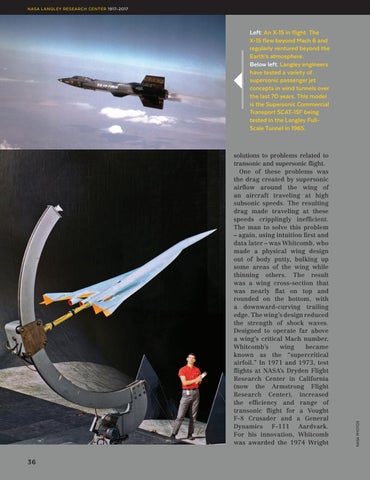NASA LANGLEY RESEARCH CENTER 1917-2017
solutions to problems related to transonic and supersonic flight. One of these problems was the drag created by supersonic airflow around the wing of an aircraft traveling at high subsonic speeds. The resulting drag made traveling at these speeds cripplingly inefficient. The man to solve this problem – again, using intuition first and data later – was Whitcomb, who made a physical wing design out of body putty, bulking up some areas of the wing while thinning others. The result was a wing cross-section that was nearly flat on top and rounded on the bottom, with a downward-curving trailing edge. The wing’s design reduced the strength of shock waves. Designed to operate far above a wing’s critical Mach number, Whitcomb’s wing became known as the “supercritical airfoil.” In 1971 and 1973, test flights at NASA’s Dryden Flight Research Center in California (now the Armstrong Flight Research Center), increased the efficiency and range of transonic flight for a Vought F-8 Crusader and a General Dynamics F-111 Aardvark. For his innovation, Whitcomb was awarded the 1974 Wright
36
NASA PHOTOS
Left: An X-15 in flight. The X-15 flew beyond Mach 6 and regularly ventured beyond the Earth’s atmosphere. Below left: Langley engineers have tested a variety of supersonic passenger jet concepts in wind tunnels over the last 70 years. This model is the Supersonic Commercial Transport SCAT-15F being tested in the Langley FullScale Tunnel in 1965.










